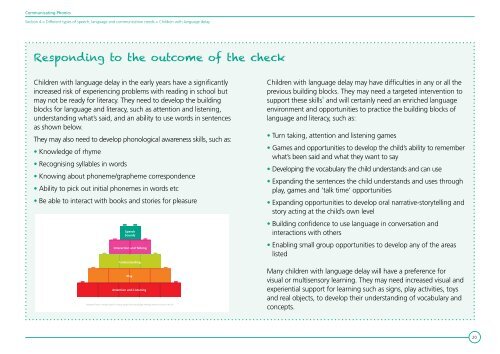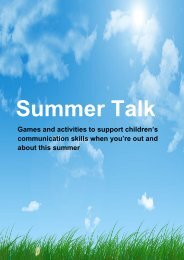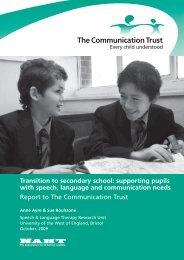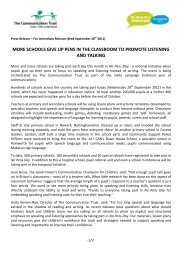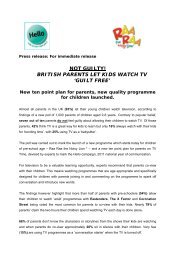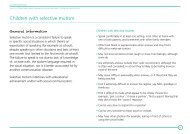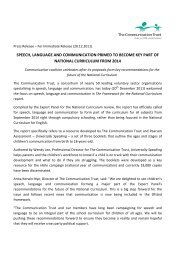Communicating Phonics - The Communication Trust
Communicating Phonics - The Communication Trust
Communicating Phonics - The Communication Trust
Create successful ePaper yourself
Turn your PDF publications into a flip-book with our unique Google optimized e-Paper software.
<strong>Communicating</strong> <strong>Phonics</strong>Section 4 > Different types of speech, language and communication needs > Children with language delayResponding to the outcome of the checkChildren with language delay in the early years have a significantlyincreased risk of experiencing problems with reading in school butmay not be ready for literacy. <strong>The</strong>y need to develop the buildingblocks for language and literacy, such as attention and listening,understanding what’s said, and an ability to use words in sentencesas shown below.<strong>The</strong>y may also need to develop phonological awareness skills, such as:• Knowledge of rhyme• Recognising syllables in words• Knowing about phoneme/grapheme correspondence• Ability to pick out initial phonemes in words etc• Be able to interact with books and stories for pleasure<strong>Communication</strong> Development PyramidSpeechSoundsInteraction and TalkingUnderstandingPlayAttention and ListeningAdapted from a model used in many speech and language therapy services across the UKChildren with language delay may have difficulties in any or all theprevious building blocks. <strong>The</strong>y may need a targeted intervention tosupport these skills 9 and will certainly need an enriched languageenvironment and opportunities to practice the building blocks oflanguage and literacy, such as:• Turn taking, attention and listening games• Games and opportunities to develop the child’s ability to rememberwhat’s been said and what they want to say• Developing the vocabulary the child understands and can use• Expanding the sentences the child understands and uses throughplay, games and ‘talk time’ opportunities• Expanding opportunities to develop oral narrative-storytelling andstory acting at the child’s own level• Building confidence to use language in conversation andinteractions with others• Enabling small group opportunities to develop any of the areaslistedMany children with language delay will have a preference forvisual or multisensory learning. <strong>The</strong>y may need increased visual andexperiential support for learning such as signs, play activities, toysand real objects, to develop their understanding of vocabulary andconcepts.20


